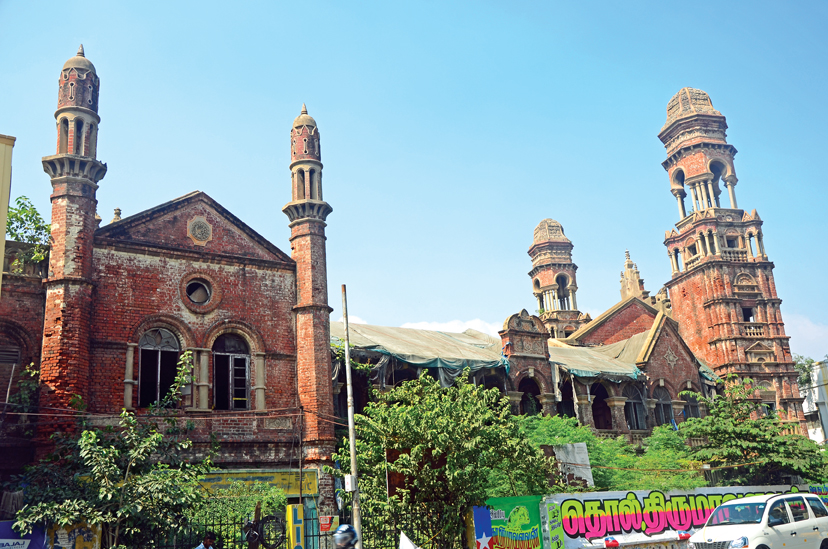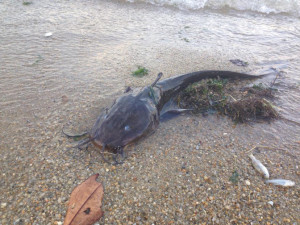Registered with the Registrar of Newspapers for India under R.N.I 53640/91
Vol. XXVII No. 19, January 16-31, 2018
Our Readers Write
A senior architect’s lament – and plea

It is painful to see the condition of wonderful Bharat Insurance Building on Chennai’s main road, Anna Salai. This Indo-Saracenic structure is now surrounded by bushes and completely damaged by nature. As a professional, I feel ashamed and wonder how a law enacted by the Government to conserve such a heritage building is just ignored. Particularly as it is owned by a public sector undertaking.
Even the Heritage Conservation Committee constituted by the Chennai Metropolitan Development Authority is unable to initiate or take action against the owners to preserve it.
The professional architectural community has thousands of members connected locally, nationally and internationally through an online network. As the ‘Voice of Architecture’, we should be the champions and custodians of the highest standards of professionalism, ethics and best practice. Hence, it is our responsibility to actively lobby the Government to influence, change, encourage feedback and opinion from all on policy and legislation. All of us can be a part of the effort to protect our heritage in many ways, such as collecting donations and using such amounts for specific purposes like conducting seminars/events, publishing newsletters etc.
Above all, it is pride in our heritage and our responsibility towards it that matters. We must be vocal against practices that destroy heritage and must spread awareness so that all come together to safeguard these heritage structures.
We have to deal with several laws that affect the well-being of the common man. The Regional Town Planning Act, the Development Control Regulations etc., have to be interpreted by us judiciously when we discharge our duties. There are other laws such as Heritage Conservation Act, Coastal Regulations Zone Act, Environmental Protection Act, Forest Act etc. that need to be studied well to be able to practice satisfactorily.
It is not too late even now for the Heritage Committee appointed by the Government to take steps towards the preservation of what is left of the City’s heritage.
Together we can make the difference.
Thank God the Taj Mahal was not built on the basis of the lowest tender!
S.L. Chitale
Dhun Building, Chennai 600 082
admin@chitalearchitects.com
Beware Pulicat’s Catfish
 Piknickers to popular Pulicat Lake, particularly children and women, love to wade barefooted in the cool and calm backwaters. They are, however, quite unaware of the stinging catfish lurking amidst the bottom weeds and slush of the brackish (salt) waters here.
Piknickers to popular Pulicat Lake, particularly children and women, love to wade barefooted in the cool and calm backwaters. They are, however, quite unaware of the stinging catfish lurking amidst the bottom weeds and slush of the brackish (salt) waters here.
The Gray Eel-Catfish or the Canine Catfish-Eel (Plotosus canius), is widely distributed in the backwater lagoons, estuaries and mangroves of Asia, particularly of the Indian subcontinent. Closer to us, it is common in the Pulicat Lake and they may even migrate into the Ennore, Adyar and Kovalam backwaters, and into the Buckingham Canal that connects them all.
Unwary waders may get stung on their toes, feet and lower legs, but the commonest victims on the Pulicat Lake are the local tribal fisherwomen who wade while crouching to collect juvenile prawns by feeling for them with their fingers in the bottom slush and weeds. They can be stung both on hands and legs.
In the Pulicat Lake, this catfish is called Irungeluthi in Tamil. It grows to about three feet in length, but usually those that inhabit the coastal shallow waters are less than a foot in length. Younger ones are grey, but older ones are dark grey. The characteristic barbels (whiskers) of catfish, are a pair of longer ones on their upper lip and three pairs of smaller ones on the lower lip. Their single dorsal (top) fin and the paired pectoral (shoulder) fins carry at their front margin a serrated sharp sting, with a groove running from the venom gland in the skin upto the tip of the sting.
Sting: Catfish sting gives a sudden burning shock, followed by intense pain and cramps, ascending up and paralysing the victim making him or her fall prostrate, as in the case of a scorpion sting. Hence this catfish in the Pulicat Lake is also called the Theli Meen (Scorpion Fish) in Tamil. Some victims sweat profusely and even become breathless and faint. They are invalid for two or three days. In the Pulicat area, the Yanadi tribal fisherfolk superstitiously believe the victim to be demon-possessed and subject the victim to all kinds of witchcraft, magic and charms.
Physician’s treatment is necessary, if available. Occasional fatal cases due to catfish sting have been known in Pulicat.
Venom: Catfish venom acts like a neuro-muscular venom for most victims, but in a few cases of old and weak victims, it brings about cardio-vascular symptoms also, depending on the age of the victim and the amount of venom injected.
Some skillful fishermen on the Pulicat Lake bite off the catfish stings!
More research on fish venoms in India needs to be attempted not only to find out the precise antivenom, but also to explore the therapeutic potentials of fish venoms in India.
– P.J. Sanjeeva Raj
rajsanjeeva@gmail.com
Sindhi settlers
I am a Sindhi and my grandparents moved to Chennai during the partition in 1947. However, they are no more now and I have a few questions about the Sindhis in Chennai.
Can you tell me where the refugee camp was located in Madras when the Sindhis and other communities came to Madras during partition in 1947? Did the camp have a name? Any other information regarding these camps and how the refugees were resettled?
Can you share any other information about the Sindhi Hindus who moved to Madras during the partition and how they survived or what business they got into? Any prominent names you might know of?
I am chronicling my family history and need this information. Unfortunately, my parents and grandparents are no more, so this enquiry. My family settled down in Madras, two generations ago.
Prakash Jashnani
prakash.jashnani@gmail.com
Editor’s Note: Try the Punjab Association, Door No. 202, Near Adharsh School Flyover, Peter’s Road, Royapettah, Chennai 600 014. Email: adarshhq@dataone.in; Ph: 044 28470925
Disappointing syllabus
Madras Musings (December 16th) has explicitly brought out the lacunae and non-appealing syllabus framed for Humanities in schools. History, Geography and Civics in one book is not only an overload but it also does not speak on the history of the land. The writer rightly points out that local study, as area study, is very important, based on the principle of “From Known to Unknown”. The syllabus does not instill pride in the development made in every sphere locally and nationally.
I hope the Department of Education and State Council of Education Research and Training (SCERT) will definitely look into the syllabus and ensure that it highlights the past through the present and leads to the future. The content and the related activities should be relevant to developing an insight among the students and inspiring them to become responsible active citizens.
Dr. Smt. Girija Seshadri
jghvmhss2004@gmail.com
Air raid shelter
The air raid shelter (Musings, December 16th) belongs to the Government of Madras. The then Madras Presidency Governor, Sir Arthur Hope, had it built in 1942 with numerous others. The marauding Japanese came as far as Rangoon.
Bombing of Madras was imminent in late 1941 and early 1942. The Governor was concerned about loss of civilian life.
He directed the City Police to organise the A.R.P. (Air Raid Precautions), a civil service organisation to advise the people about the air raids, observe black out, take shelter when the siren wailed and come out when it gave the all clear – a long steady sound. Wardens, Messengers, First Aiders, and Doctors were appointed under this scheme.
Ambulances were bought by the late Dr. M. Santhosham, who was a prominent figure in the A.R.P. Deputy Commissioner of Police, D. Latham, was the Controller of the A.R.P. He organised the Auxiliary Fire Service (A.F.S.) also with 29 Fire Stations, with two fire appliances each and some ambulances.
I joined the AFS in Madras. Nine pucca fire stations were built on a war footing. I saw the High Court Fire Station being built overnight, the work lighted with petromax lights. The Governor also sanctioned Rs. 40 as Evacuation Advance to every government servant advising them to send their families to the villages. I also received Rs. 40.
Aaron David
Retired Divisional Fire Officer
No. 2, Thommayappen Street Royapettah, Chennai 600 014
Nostalgic memories
The January 1st issue of Ma-dras Musings is a veritable collection of nostalgic memories. The first one by the elder brother of Subbudu reveals the struggle of the critic. Subbudu had often preferred to be in the mould of Dr. Johnson who would be lavish in his praises and biting in his criticisms. He expected the artistes to be models of perfection and he could not digest ordinary performances by the great musicians. Similar is V. Sriram’s article on JBS which had its own halo during its heydays. The lesson learnt is that any organisation, political or social, dependent on a single soul will face demise sooner or later.
S.S.Rajagopalan
30,Kamarajar Street
Chennai 600 093
Reposition box
I have been reading Madras Musings for many years and would appreciate your considering this suggestion.
Please print the ‘box’ pertaining to subscription/donation on the seventh page, just behind where “Madras Musings is supported as a public service by the following organisations” is printed as you have occasionally done.
While sending subscription/ donations, the ‘box’ is cut and filled and then despatched to you. When it is cut, on other pages, some important articles also get cut. Many preserve Madras Musings for years.
R.K. Bhuwalka
D 405 Ashok Gardens
Tokersey Jivraj Road
Sewree, Mumbai 400 015
Editor’s Note: We try to do exactly what reader Bhuwalka suggests, but only too often, the length of articles does not make it possible. We know it is inconvenient, but can only suggest Xeroxing the box when it is badly positioned and sending the copy. Or a scribble on the wrapper with address will do.

